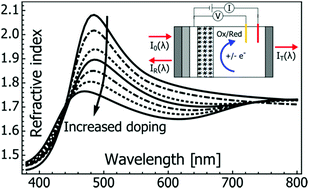On the asymmetric evolution of the optical properties of a conjugated polymer during electrochemical p- and n-type doping†
Abstract
We report on the in situ measured evolution of the spectral complex refractive index of a prototypical conjugated polymer, a phenyl-substituted poly(para-phenylenevinylene) copolymer (Ph-PPV, “Super Yellow”), during electrochemical p- and n-type doping. We find that the real part of the refractive index is lowered in a significant and continuous fashion over essentially the entire visible range with doping, as exemplified by a drop in the peak value at ∼480 nm from 2.1 for pristine Ph-PPV to 1.8 at a p-type doping concentration of 0.2 dopants per repeat unit and an n-type doping concentration of 0.6 dopants per repeat unit. The imaginary part features a concomitant distinct bleaching of the high-energy π–π* transition and the emergence of a low-energy polaron band. Interestingly, we observe that the optical response of Ph-PPV to p-type and n-type doping is highly asymmetric, with the former resulting in much stronger changes and a distinct blue-shift of all optical transitions. We tentatively attribute this difference in response to larger effective size of the p-type polaron compared to the n-type polaron. We anticipate that the presented results should be of value for the rational design of emerging optical devices that utilize the doping capacity of conjugated polymers.



 Please wait while we load your content...
Please wait while we load your content...